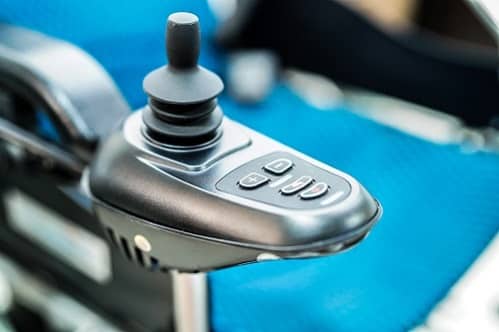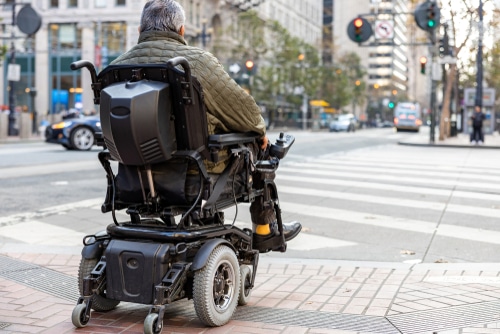It’s a big decision… rear, mid or front wheel drive power wheelchair? Which one is right for you? With various models on the market, you may be wondering how to choose the right electric wheelchair drive for your needs.
You’ve come to the right place; let us help you make the right move.
Different drives will affect your ability to operate move your chair safely, comfortably, and independently. So you have to land on the right decision before buying your chair. With factors like your lifestyle, comfort, manoeuvrability, battery life and terrain to consider, here’s a rundown on choosing the correct drive:
Table of contents

Types of electric wheelchair drives
When it comes to electric wheelchair drives, you’ll typically find front-wheel, mid-wheel, and rear-wheel drives. It’s all dependent on the location of the motor and the wheels’ placement on the chair.
Here’s a breakdown of each type:
Front-wheel drive
With a front-wheel drive power wheelchair, the motor and the drive wheels are located at the front of the wheelchair. This design provides good traction and stability when driving over uneven terrain, making it ideal for outdoor use.
However, it may be more difficult to manoeuvre in tight spaces and the front wheels can get caught on obstacles.
Mid-wheel drive
In this type of drive, the motor and the drive wheels are located in the centre of the wheelchair. The placement of its wheels makes it feel very balanced when it’s spinning in a circle, hence this design allows for excellent manoeuvrability in tight spaces.
It’s ideal for indoor use, but may not provide as much stability as front-wheel or rear-wheel drives. It will also find uneven terrain a challenge. Though mid-wheel drive chairs can manoeuvre outside, their front wheel castors struggle to gain traction over soft surfaces such as grass, so you’ll want to use compact surfaces as much as possible.
Rear-wheel drive
This is considered the best type of chair for outdoor use. With this type of drive, the motor and the drive wheels are located at the back of the wheelchair. This design provides excellent traction and stability, making it ideal for those who require more power.
However, it may be less manoeuvrable in tight spaces and is considered the hardest to use inside.
This video gives excellent visuals of each type of electric wheelchair:
Which drive is best for me?
Ultimately, the best electric wheelchair drive type for you depends on your specific needs and preferences. Factors such as your mobility level, lifestyle, and intended use of the chair all play a part. Your first steps may be consulting with your occupational therapist (read about occupational therapy for wheelchair scripting), seating specialist or healthcare provider and trying out different models to find the one that meets your need.
Here are key elements for consideration:
Lifestyle
Consider your daily activities and lifestyle. If you plan to use your wheelchair mainly indoors or in tight spaces, a mid-wheel drive may be the best option. Inversely, if you spend a lot of time outdoors or on rough terrain, a rear-wheel drive may be more suitable. If you’re outdoors as much as indoors and moving mostly over compact surfaces, a front wheel drive power wheelchair would be suitable.
Power needs
Consider the power needs of the chair. If you require more power to navigate hills or rough terrain, a rear-wheel drive may be the best option. If you need a more lightweight and manoeuvrable chair, a front-wheel drive or mid-wheel drive may be more suitable.
Personal preference
Finally, consider your personal preference. Test out different models to see which drive type feels the most comfortable and suits your needs. Speaking of comfort, read our article: 8 Tips to Make Your Wheelchair More Comfortable.
This helpful video gives two people’s experiences in picking between a mid-wheel and front wheel drive power wheelchairs:
How much does an electric wheelchair cost?
Regardless of which drive you go for, the cost of an electric wheelchair in Australia can be significant and vary widely. It all depends on the brand, model, features, and customisation options you require.
On average, a standard electric wheelchair can cost between $500 to $10,000 or more. Many people need specialised work on their chair beyond that, to personalise it for their needs.
Keep in mind that you may be eligible to have the cost partially covered by the National Disability Insurance Scheme (NDIS). The NDIS provides funding for assistive technology, including electric wheelchairs, based on your individual needs and goals. Check out more info in our article titled Will NDIS Fund My Wheelchair?
Securing wheelchair funding through the NDIS is not the only solution. Be sure to check out our piece Alternatives to NDIS for Funding a Wheelchair or Mobility Scooter to find out what other options there are for you.

How long does an electric wheelchair last?
The lifespan of an electric wheelchair can vary depending on several factors, such as the frequency of use, maintenance, quality of components, and battery condition. On average, an electric wheelchair can last between 3 to 5 years. However, with proper care and maintenance, some chairs can last up to 10 years or more.
Regular maintenance can help extend the lifespan of your chair. This may include checking and tightening screws and bolts, cleaning, and inspecting the battery for signs of wear and tear. It’s also essential to follow the manufacturer’s guidelines for charging and maintaining the battery, as this can significantly impact the lifespan of the chair.
Factors such as extreme temperatures, exposure to moisture or saltwater, and rough terrain can also affect the lifespan of your wheelchair. It’s important to use it in appropriate conditions and take necessary precautions to protect it from damage. Be sure to check out our guide: Tips On How To Maintain Your Wheelchair or Mobility Scooter.

How much do electric wheelchairs weigh?
The weight of electric wheelchairs can vary widely depending on the size, features, and materials used in making them. On average, most standard electric wheelchairs weigh between 45 to 135kg including the batteries.
Smaller, more compact wheelchairs designed for travel or indoor use (such as the mid-wheel electric wheelchair drive) can weigh as little as 23 kg. Heavy-duty electric wheelchairs designed for outdoor use (such as a rear-drive chair) or larger individuals (a bariatric wheelchair) can weigh up to 180kg or more.
Some models may be designed with lightweight materials or foldable frames to make them easier to transport. Additionally, some electric wheelchairs may have detachable parts, such as the seat or battery, to reduce their overall weight when necessary.
More resources for you
Now you know more about electric wheelchair drive options, check out some of our other handy resources below:
- Powering Your Manual Wheelchair
- Children’s Wheelchairs – What You Should Know
- The Latest Innovations in Assistive Technology
- Seven Useful Wheelchair Accessories To Help You On Your Way
- Are Electric Cars for Wheelchair Users a Reality or Not?
Insurance for your electric wheelchair
As safe as you try to be in your wheelchair, everyday obstacles can present unexpected hazards. Footpaths, pedestrians, cyclists, road crossings and driveways can create dangerous situations and, unfortunately, accidents happen. So too, do wheelchair thefts and vandalism (sad but true).
This is why we’ve created a series of unique features and benefits in our policy specifically for wheelchair users. You can find out more here in our comprehensive wheelchair insurance policy description.








